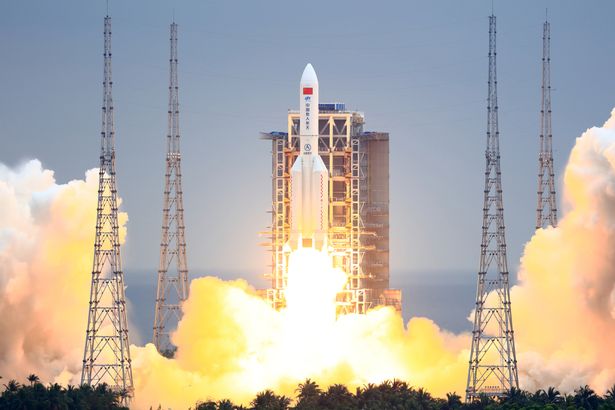A 21-ton Chinese rocket is expected to fall to Earth in an uncontrolled way and experts have warned it could land in populated areas.
The Long March 5B blasted off last Wednesday and successfully delivered the core module of China’s space station, Tianhe, into orbit.
But the 30-metre long rocket also reached orbit and experts fear it could make an uncontrolled reentry in the next few days.
The core stage could be dragged to Earth and potentially land on an inhabited area, Space News reports.
Spaceflight observer Jonathan McDowell told the website: “The Long March 5B core stage is seven times more massive than the Falcon 9 second stage that caused a lot of press attention a few weeks ago when it reentered above Seattle and dumped a couple of pressure tanks on Washington state.”

(Image: VCG via Getty Images)
The rocket is believed to be orbiting the Earth every 90 minutes and is passing just north of New York, Madrid and Beijing, and as far south as Chile and Wellington, New Zealand – prompting fears it could land on inhabited areas.
It measures about 100 feet long and 16 feet wide.
Once it falls out of orbit, it may burn up in Earth’s atmosphere, but pieces of debris may fall.
Even though they are likely to fall in the ocean, there is a risk some of them could fall in inhabitated areas.

(Image: China News Service via Getty Ima)
Mr McDowell said: “I think by current standards it’s unacceptable to let it reenter uncontrolled.”
In a tweet, the astronomer wrote: “The core stage apogee continues to come down slowly.
“No new data today on Tianhe itself, which could indicate it made an orbit raising burn and tracking has lost it for now.”
Holger Krag, head of the Space Safety Programme Office for the European Space Agency, said: “It is always difficult to assess the amount of surviving mass and number of fragments without knowing the design of the object, but a reasonable ‘rule-of-thumb’ is about 20-40% of the original dry mass.”
China aims to complete its space station by the end of 2022 after further modules are launched, according to local media.
Tiangong Space Station will orbit Earth at an altitude of 211 to 280 miles once complete.


